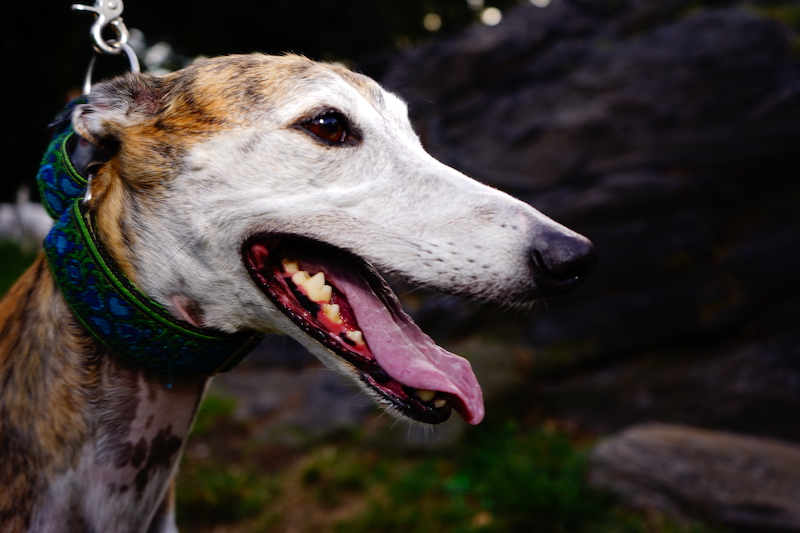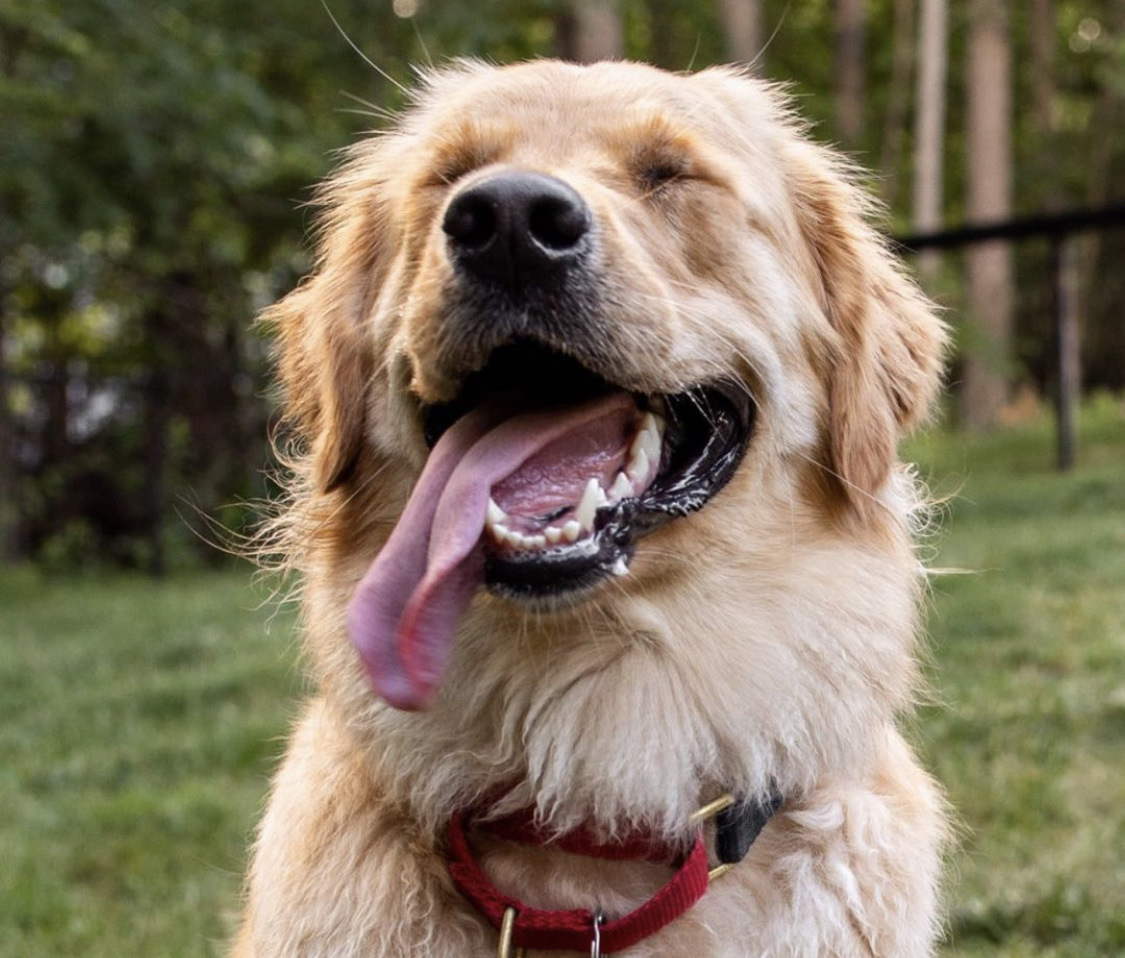Dental care for your dog isn’t just about avoiding bad breath. It’s an important part of your dog’s overall health, and an area you never want to neglect.
Below, we’ll run through some key ways to keep your pup’s pearly whites in stellar shape.
Why is it important to clean my dog’s teeth?
Ah, there’s nothing quite like snuggling up with your four-legged companion. They cuddle close to you for warmth, lean in for a nuzzle—and blast you with some truly foul doggie breath.
When your dog’s mouth is neglected, there’s nothing to stop the bacteria multiplying, causing bad breath—as well as other serious health problems.
Like humans, dogs get plaque on their teeth. If you don’t brush it off regularly, it turns into hard tartar which only a vet can remove. Over time, tartar buildup can cause gum disease (gingivitis), abscesses, a loss of the bone that teeth are anchored in, and loose teeth that cause your pain.
Plus, dental problems don’t stay in the mouth. Bacteria can travel through the bloodstream and potentially damage the kidneys, heart, lungs, and other organs.
Dental issues are extremely common. According to the American Veterinary Medical Association, up to 80% of dogs show signs of canine periodontal disease by the age of 3. Woof.
How often should I have my dog’s teeth cleaned?
Your pet’s teeth need both regular dental care at home, and professional dental cleaning. You should brush your dog’s teeth at least once a week, and ideally every day.

Once a year, it’s recommended to take your dog to the vet for professional cleaning and an oral checkup. Some small breeds—like bulldogs, pugs, and Yorkshire terriers—are more susceptible to periodontal disease because their small mouths cause tooth crowding. These dogs need checking every 6 months or so.
Beyond this cadence, you’ll want to schedule an oral exam if you notice any of the following symptoms of dental issues:
- Bad breath
- Excessive drooling
- Teeth that are brown, red, or another odd color
- A lack of interest in favorite toys
- Bleeding gums
- Poor appetite
- Teeth that are loose or fall out
- Sneezing and nasal discharge
How much will dog teeth cleaning cost?
The cost of professional teeth cleaning depends on where you live, the condition of your dog’s teeth, and how much work the vet has to do.
Cleaning could run from $500 up to $1,000, and more if you need oral radiographs. Going to a veterinary dental specialist for cleaning and tooth extractions could come to $2,000–$3,000.
Fortunately, with Lemonade Pet Insurance, you can add our Preventative+ package (for pets over the age of 2), which covers routine dental cleaning in addition to many of your dog’s vaccines, tests, and flea and heartworm medications.
Lemonade also offers a dental illness add-on, which can help cover the cost of treatments, procedures, diagnostics, and medications related to dental illness. This includes: crowns, extractions, root canals, dental surgeries, and treatments for gum disease like gingivitis and periodontal disease.
What exactly will happen during my dog’s tooth cleaning?
One reason cleaning procedures can get so pricey? Dogs have to be under anesthesia during professional teeth cleaning, otherwise it’s impossible to clean below the jaw line properly.
The first thing the vet does will do is run lab tests and blood work to check on your dog’s overall health and estimate how they’ll react to general anesthesia.
Once your pet is under, the vet cleans the teeth to remove plaque and tartar, focusing as well on areas where a toothbrush won’t reach. Then they’ll polish the teeth, and sometimes add fluoride or other oral hygiene products to help prevent the return of plaque.
Meanwhile, the vet will check your dog’s mouth for cavities, teeth that no longer have a blood supply, and signs of periodontal disease. They’ll fill and extract teeth if needed, and might take dental x-rays to examine the roots of the teeth.
It can take anything from 45 minutes to 4 hours to complete a full oral checkup.
How can I help keep my dog’s teeth clean?
What you do at home has a big impact on your dog’s oral health. No pressure! Except… a little bit of pressure, since your pup is counting on you.
To brush your dog’s teeth, get a dog-specific toothbrush with soft bristles that’s angled to make it easier to reach all the nooks and crannies in their mouth. If that doesn’t work, try a finger brush. You might need to try a couple of models before finding one that your dog accepts.
Don’t forget the toothpaste! Pet-friendly paste comes in lots of dog-approved flavors, like chicken, liver, and peanut butter. (Don’t use human toothpaste: the ingredients are toxic for dogs and can cause serious harm.) Let your dog sniff and lick the toothpaste before you start, to help them get used to it.
To brush their teeth, run your traditional toothbrush or finger brush between the teeth and your dog’s cheek. Aim for two or three strokes on the right, the left, and the front of the mouth. Your dog might not like the sensation at first, but most pets grow accustomed to it.
Sprays and chews
As well as regular brushing, you can improve your dog’s dental health with dental treats and toys, like doggy dental chews. These help reduce plaque buildup while polishing the teeth and encouraging blood flow to the gums, which helps prevent dental disease.
Chew toys are also great for dental care, because chewing rubber or rawhide scrapes plaque off the teeth. Look for chew treats and toys that are approved by the Veterinary Oral Health Council (VOHC), and always supervise your dog when they’re chomping away.
Another oral health shortcut: dental sprays, including top-rated versions from brands like Arm & Hammer and Pets Are Kids Too. These sprays kill bacteria in your dog’s mouth to fight plaque (and bad breath). If your dog won’t sit still long enough to spray their mouth, squirt their favorite toys so they’ll lick it off instead. These products work best if your dog doesn’t eat for half an hour before or after use.
In addition, water additives can also help with your dog’s oral hygiene. HealthySmiles recommends options from Oxyfresh, Petlab Co., and Tropiclean.
If your particular dog is very susceptible to oral health issues, your vet might recommend a specific diet.

Doggy dental care is part of your pet’s overall health
While rough breath might be the most obvious sign of poor dental hygiene, the underlying health repercussions for your pet can be more severe. Keeping your pup’s mouth bacteria-free is a vital part of their everyday routine, just like exercising and eating well.
And we’d be remiss if we didn’t remind you of how Lemonade Pet can help take the bite out of vet bills—including those related to dental hygiene, if you choose a Preventative+ package. Click below to get started.
A few quick words, because we <3 our lawyers: This post is general in nature, and any statement in it doesn’t alter the terms, conditions, exclusions, or limitations of policies issued by Lemonade, which differ according to your state of residence. You’re encouraged to discuss your specific circumstances with your own professional advisors. The purpose of this post is merely to provide you with info and insights you can use to make such discussions more productive! Naturally, all comments by, or references to, third parties represent their own views, and Lemonade assumes no responsibility for them. Coverage and discounts may not be available in all states.




